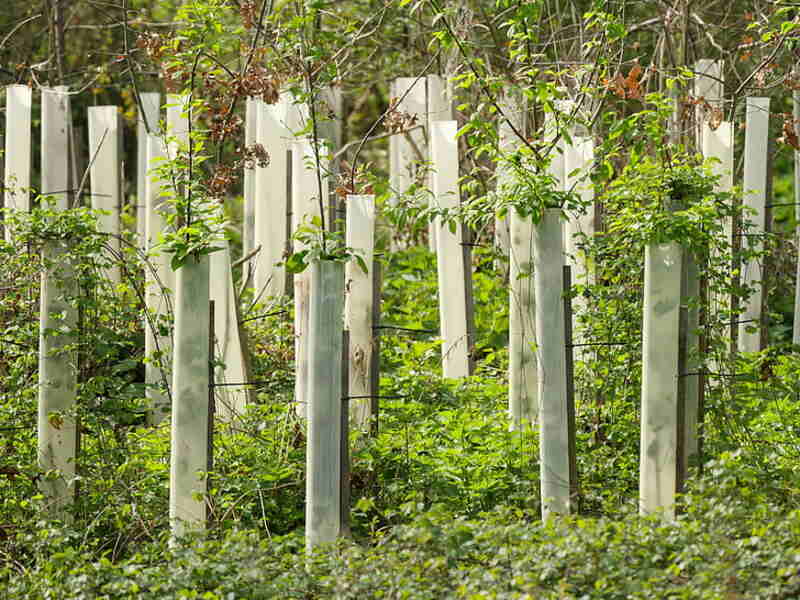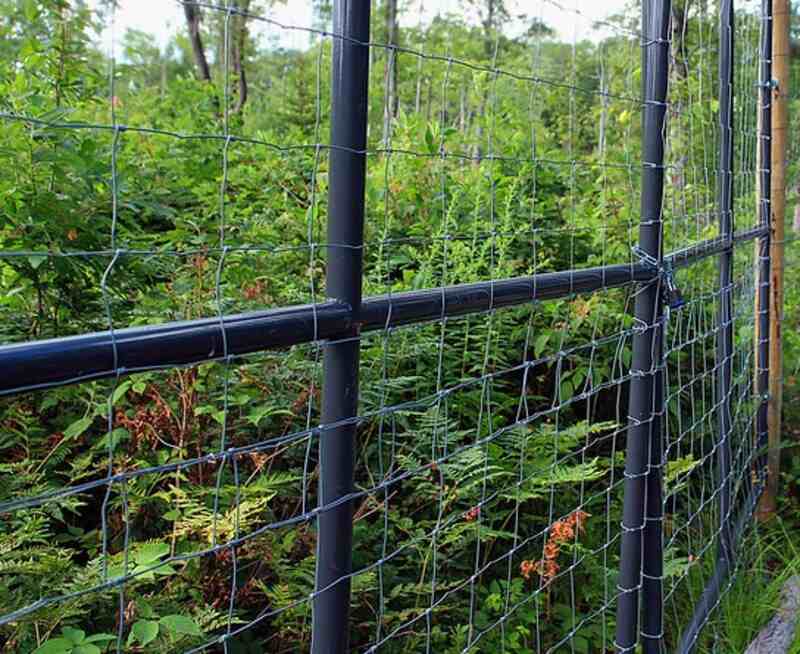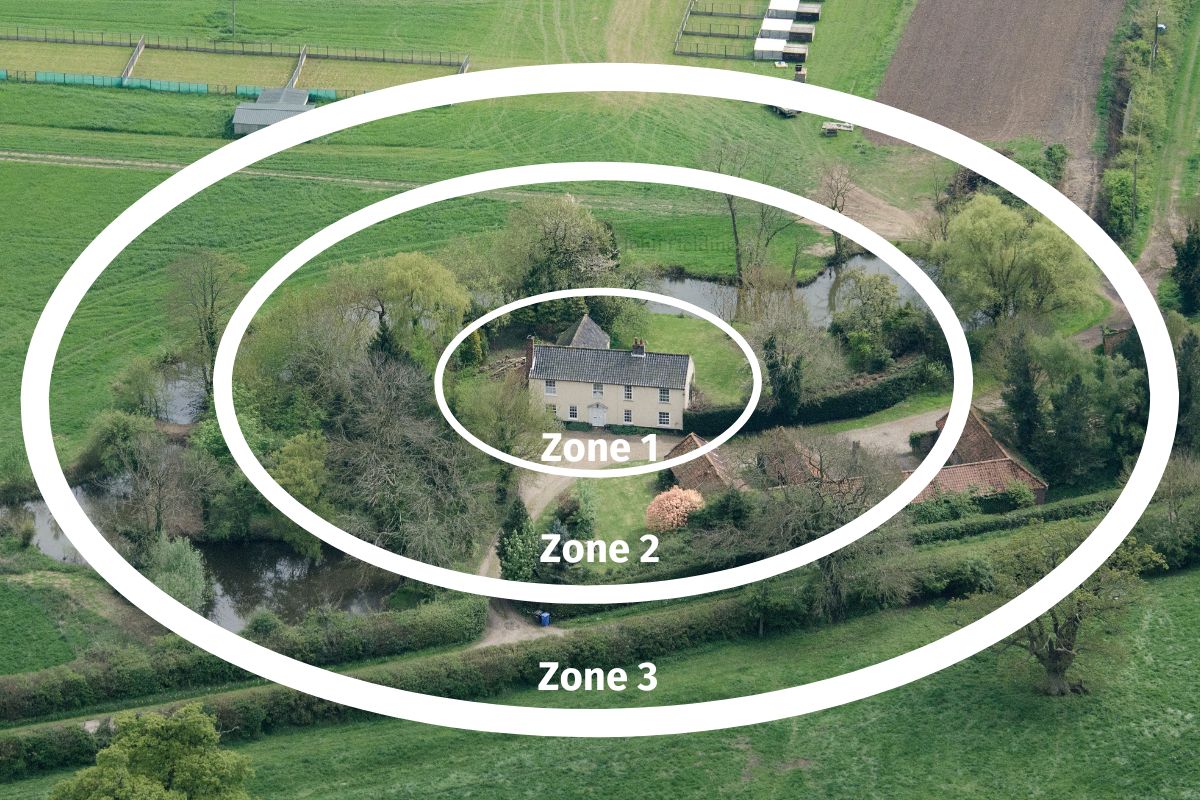
Deer can be wonderful creatures to watch, but they can also damage your yard. If you want to keep deer out of your garden and yard, there are things you can do. Adding fences, enclosures for your garden, and planting deer resistant shrubs, trees, ground cover, and perennials are effective ways to keep these four-legged garden-destroyers at bay.
In This Article:

Fences Keep Deer Away
- Tall fences. A deer can easily jump 7 feet or more, so to keep deer out you will want to install a fence that is at least 8 feet high. In addition, it needs to be made of strong material, such as chain link or welded wire, or be a brick wall.
Look for fencing “that has large enough spacing in the fence itself, as well as gaps below the fence, to allow other animals to pass through without getting stuck,” according to Kim Eierman, author and founder of the horticultural design company EcoBeneficial.
- Double fences. Two sets of 4-foot fencing with 4 feet of space between them is an alternative suggested by Eierman. “Deer have poor depth perception (because their eyes are on the sides of their head) and tend not to jump if they think they may get stuck in between the two fences.”
- Electric fences. A shock will drive off a deer. But because of their size and the fact they have hollow hair, a strong shock is needed. You might want to leave it on around the clock for a month, then put it on a timer that turns it off during the day.
A pro’s tip: If you have a deer problem serious enough to require an electrified fence, hang tinfoil that has peanut butter in it along the fence, some 20-40 feet apart. It attracts the deer, they touch it with their nose, get a shock, then make it a point to stay away.
Exclosures Can Keep Deer Away
Exclosures are physical barriers designed to keep deer away. They do not kill the deer, and can often be installed as a DIY project.

A study by the Natural Resources Conservation Service, an agency of the U.S. Department of Agriculture, found:
- Fences are the most effective method of exclosure but also the most expensive. A LawnStarter study found that the cost of installing a fence, including materials and professional labor costs, comes to $27 per linear foot.
- Tree shelters (also called tree tubes or tree protectors) protect just-planted trees. These cylinders can also be used on other plantings, but you don’t plant a garden to look at a bunch of plastic tubes. There is a cost (as low as $1 apiece), and they take time to install and to monitor. The cost in money and time might make a fence a better option, especially for large areas.
- Bud caps or terminal nets are inexpensive deer deterrents, but they often come off (a real concern in rain) and have to be reinstalled. It is simple to do, making them a good DIY project, but a time-consuming one.
A Micro-Exclosure Might Work for You
In an experiment, the University of Minnesota Extension had a micro-exclosure built. They created a deer fence out of cattle panels (also known as feedlot panels), which are heavy duty ¼-inch galvanized rods that are welded into a grid, and are regularly used in gardens. The panels were set up in a small lot. The experiment found:
- It worked. It kept out the deer.
- It was mobile. It could be moved around as needed.
- It was cost-effective. It could be built with $150 in materials.
- It was simple. You could set one up as a DIY project.

Make Your Yard Taste Terrible with Deer Resistant Plants
One way to discourage deer is to landscape with deer-resistant plants.
Caveat: No plant is completely deer-proof. “If deer are starving they will try to eat just about anything,” Eierman says.
Plus, deer don’t need to be facing starvation to nibble on emerging growths. “Any plant with newly emerging tender leaves may be browsed by a hungry deer, especially young fawns,” Eierman says.
Some deer-resistant plants:
Deer Resistant Shrubs
A LawnStarter study recommends these deer-resistant shrubs:
| Shrub | USDA zones | Sun needs | Drought tolerance |
| Boxwood shrubs | 4-9 | Partial shade | High |
| Juniper | 3-9 | Full to light shade | High |
| Russian sage | 4-9 | Full | High |
| Arrowwood viburnum | 2-8 | Full to partial shade | Low |
| Lilac | 2-7 | Full | Low |
| Dogwood | 5-8 | Full to partial shade | Vulnerable to drought and to flooding |
Deer Resistant Trees
| Common Name | Scientific Name |
| Ginkgo | Ginkgo biloba |
| Crape Myrtle | Lagerstroemia hybrids |
| Chastetree | Vitex agnus-castus |
Deer Resistant Ferns
In holding off deer with ground cover, ferns are a good choice. Deer do not feed on them. Plus, ferns prefer to grow in the shade, so they can be planted under or around other plants.
| Autumn Fern | Dryopteris erythrosora |
| Holly Fern | Cyrtomium falcatum |
| Japanese Painted Fern | Athyrium nipponicum var. pictum |
| Tassel Fern | Polystichum polyblepharum |
Deer Resistant Ground Cover
If you don’t want to grow a fern, the Missouri Botanical Garden suggests these ground covers:
| Ground cover | Scientific name | Sun or shade |
| Aromatic aster | Aster oblongifolius | Full sun |
| Bloody cranesbill | Geranium sanguineum | Full sun or part shade |
| Mondo grass | Ophiopogon japonicus | Full or part shade |
Deer Resistant Perennials
Deer love to munch on tulips, hostas and daylilies. But there are a number of perennials that they don’t like:
| ‘Powis Castle’ Artemisia | Artemisia x ‘Powis Castle’ |
| Angel’s Trumpet | Brugmansia species and hybrids |
| Daffodils | Narcissus pseudonarcissus |
| Dianthus | Dianthus gratianopolitanus |
| Blanket Flower | Gaillardia x grandiflora |
| Lenten Rose | Helleborus orientalis |
| Red Hot Poker | Kniphofia species |
| Lantana | Lantana species |
| Catmint | Nepeta species and hybrids |
| Russian Sage | Perovskia hybrids and varieties |
| Anise Sage | Salvia guaranitica |
| Mexican Bush Sage | Salvia leucantha |
| Society Garlic | Tuhlbughia violacea |
Mix Herbs Into Your Garden
Deer clearly avoid plants with strong fragrances, so one thing you can do to keep away deer is to mix herbs into your garden, placing them in your flower beds and among other favorites.
Some people like to use herbs as a border in their gardens. Certainly that will work, but you will need a large border to keep deer from crossing over.
Some good herbs to use:
| Herb | Scientific name |
| Basil | Foeniculum vulgare |
| Chives | Allium schoenoprasum |
| Lavender | Lavandula stoechas |
| Mint | Mentha species |
| Oregano | Oreganum species |
| Sage | Salvia officianalis |
| Thyme | Thymus species |
Create Zones to Fight Off Deer
The xeriscape concept of landscaping is an effort to use as little water as possible. One of the concepts is to divide the area into zones and to put appropriate plants into each. That concept can be applied to the effort to keep out deer:
- Divide the area into zones.
- Zone 1: Place the plants deer like in the zone nearest to the house. Either put up a fence, or spray regularly with deer deterrents.
- Zone 2: In the middle area, you can create a zone in which you place plants that are less resistant to deer but have elements you like to see in your yard.
- Zone 3: In the far zone, the one at the edge of the property, place the most deer-resistant plants. Count on them to drive the deer away.

Deer Repellents
A Do-It-Yourself Deer Repellent Spray
There are a lot of DIY deer repellent spray recommendations out there. However, the University of Minnesota Extension recommends this one:
- Mix three eggs in water in a blender
- Pour the mix into a container, add water until you have a gallon, then strain it.
- Spray the mix onto plants until the leaves are noticeably wet.
- Repeat the spraying every two weeks and after any rainfall
Eierman suggests that if you want to purchase a deer deterrent spray, you look for one that has been approved by the Organic Materials Review Institute (OMRI) as a listed organic product.
Other Deer Repellents
- Chili powder. Sprinkle liberally around the areas you would like deer to avoid. You will have to apply it over and over because rain and chili-loving insects will carry it away.
- Dogs. Sometimes just the mere presence of dogs can deter deer. At other times, a confrontation with a dog, or the barking of one, will drive away deer. Once they know a dog is present, deer are likely to avoid the area.
- Human hair. Ask your barber for hair clippings, and toss them around the base of the plants to serve as a deer deterrent. Hair will naturally decompose into the soil, so you will need to replenish the supply.
- Reflective light. Hang aluminum plates or metal CDs so they turn in the breeze. The reflective light causes deer to steer clear.
- Soap. Hang strongly-scented bars of soap (Irish Spring soap is often cited) in mesh bags around your lawn and garden beds. They even work around a vegetable garden.
- Water sprinklers or sprayers will scare deer off. Motion-activated sprinkler systems or ones turned on with a timer are available.
- Wind chimes. Deer startle easily, so the sound of wind chimes can cause them to leave an area.However, they only work if there is wind. And deer will quickly get used to the sound and not be bothered by it.
- Ultrasonic deer repeller. This is a simple noise-making machine that uses sound to deter deer and reduce deer damage. It emits sounds at a level that most humans cannot hear, around 20 kilohertz. However, some people and animals can also hear the noise, so it may not be the best possible solution, especially if you have neighbors.
Deer Will Adjust to What You Do
A study by the Natural Resources Conservation Service, an agency of the U.S. Department of Agriculture, found that deer:
- Learn to tolerate bad smells, lights, siren-like noises, and other scare tactics.
- Jump high, as high as 12 feet if they have to.
- Can crawl through openings of 7.5 inches
- Learn to remove netting used to protect plants
- Test for weaknesses in barriers, and will do it over and over
- Will munch on stems emerging from mesh protectors used to wrap a tree
- Will ignore chemical repellents to nibble on stems growing from plants liberally sprayed with them
When to Call In a Professional
If you don’t want deer coming into your yard or garden, there are a number of things you can attempt as do-it-yourself projects. If you have the time and skills, you can even take on some more advanced efforts, such as installing a fence.
But be careful about the amount of time such efforts will require, and of the specialized knowledge it might take. You might be better off hiring a professional, perhaps even one who can apply Integrated Pest Management techniques to keep deer away.
The national average cost for removing wildlife is $255 to $600, a LawnStarter pricing guide has found.
FAQs
A chemical repellent is registered in Kentucky for use on edible crops. The key ingredient is 15% ammonium soaps of higher fatty acids. You can spray it on plants in the garden, including things you might eat. It must be applied every 2-4 weeks and after any rain. Thiram and bone tar oil are other active ingredients in commercial deer repellents.
With that in mind, it might cost less to put up a fence.
Deer do not like to eat leaves that are hairy or rough or stems that are spiny. Lamb’s ear and oakleaf hydrangea have leaves with textures deer do not like.
Be careful about trying to remove deer on your own. In many places, they are protected. A LawnStarter study recommends that you arrange for a licensed nuisance wildlife control operator to handle any removal. A wildlife removal costs from $255 to $600 for a one-time intervention, LawnStarter found.
Deer have 297 million olfactory receptors in their nose. Humans have a mere 5 million. Dogs have 220 million.
A Call to Action
Don’t wait for deer to make their way into your yard before considering the potential for damage. Think about it, and if it is a concern, take action. In the planning stages of your garden, consider what plants you want to place and where you want to place them, or hire a landscaping professional to do the work for you. You might need to start by installing a fence.
Whatever you want to do, make a decision and take the right action.
Additional source: PennState Extension
Main Image Credit: Pexels